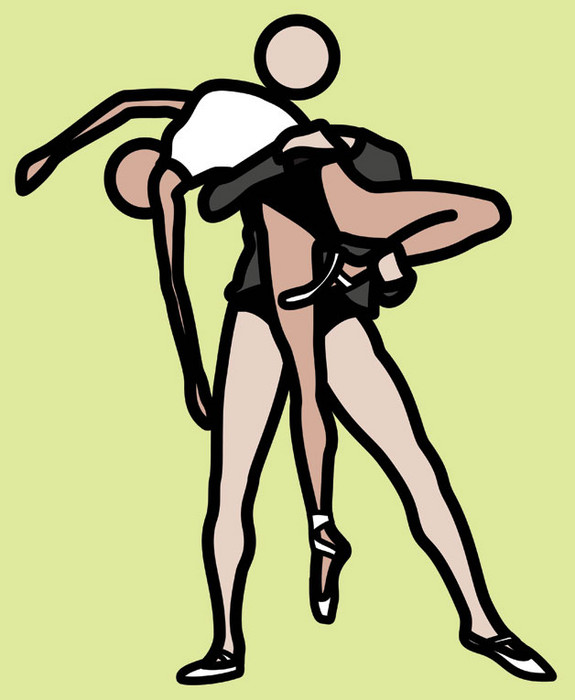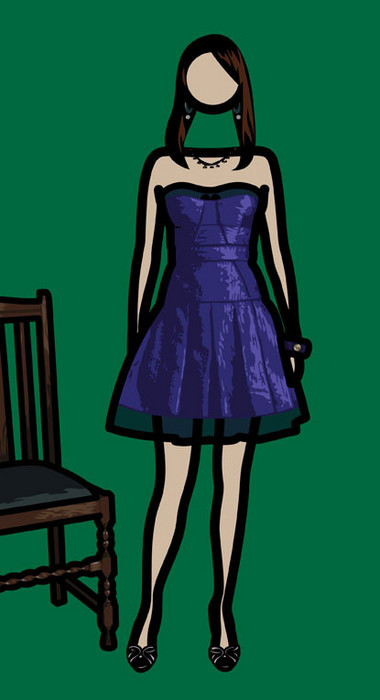Julian Opie
08 Apr - 14 May 2011

Julian Opie
Ed and Marlanela. 3, 2010
Vinyl on wooden stretcher
235 x 193 cm
Copyright the artist / Courtesy Galerie Bob van Orsouw, Zurich
Ed and Marlanela. 3, 2010
Vinyl on wooden stretcher
235 x 193 cm
Copyright the artist / Courtesy Galerie Bob van Orsouw, Zurich

Julian Opie
At the studio with Ika 3, 2011
Vinyl on wooden stretcher
274.5 x 149 cm
Copyright the artist / Courtesy Galerie Bob van Orsouw, Zurich
At the studio with Ika 3, 2011
Vinyl on wooden stretcher
274.5 x 149 cm
Copyright the artist / Courtesy Galerie Bob van Orsouw, Zurich

Julian Opie
Aniela disrobed 8, 2011
Vinyl on wooden stretcher
295 x 146.5 cm
Copyright the artist / Courtesy Galerie Bob van Orsouw, Zurich
Aniela disrobed 8, 2011
Vinyl on wooden stretcher
295 x 146.5 cm
Copyright the artist / Courtesy Galerie Bob van Orsouw, Zurich
Julian Opie
8 April – 14 May 2011
The very first sight of Julian Opie’s portraits burns them indelibly into viewers’ brains. Perhaps thanks to the reductive formal vocabulary that, on the one hand, arouses associations with comic-strips while, on the other, cites Pop Art. With his portraits the artist, born 1958 in England, has achieved an important place in recent art history by his reference to different compositional principles of portrait painting as well as to their historical manifestations. He has thereby triggered a discussion on the portrait and its identifiable features in today’s era of mass media, which Pop Art had already begun. However, Opie’s interest is anthropocentric and less product-oriented; his oeuvre deals with ways of depicting the human body and its programme of movement. In his art he is engrossed in detaching the “image“ from its support, showing that pictures are not two-dimensional surfaces, but require us to explore how they are applied. Hereby—and according to his requirements—he switches from painting to sculpture, from large scale LED installations in urban space to indoor animations on screen.
With this exhibition Julian Opie continues a collaboration with Galerie Bob van Orsouw that has existed since 1996. He will take over the two gallery rooms with paintings and sculptures that display various pictorial typologies, creating different cabinet situations.
In the left room, he will show a series of full body portraits of women in which the poses, composition and background refer back to European portrait paintings of the 15th to 18th centuries, from Titian through Van Dyck to French and English old masters. The particularity of these portraits is that they are commissioned works by collectors, which links the series even more to the portraiture tradition. Although the settings are stately homes and castles of the past, the models are dressed in recognisably contemporary fashion. Opie applies his formal reductive linear language to both figures and objects.
In the right room, pictures of a dancing couple will be on exhibit. Opie portrayed the dancers from the London Royal Ballet in moments of the piece “Infra“. With their bodies they occupy a right-angled spatiality that alludes to the shape of the picture frame. As in the other room, these drawings have also been made in a computer cut vinyl system generally used for public signage. Though the head of the figures remains a simple circle, for the first time in this series the artist has included the expressive feet of the dancers.
The charm of Julian Opie’s works is, on one hand, based on the seeming simplicity of their images, on the other on the complexity of their construction modes. For, beyond all this, his works promote an engagement with depictions of the human body in today’s media and in a world in which marketing and truncated messages increasingly define content.
8 April – 14 May 2011
The very first sight of Julian Opie’s portraits burns them indelibly into viewers’ brains. Perhaps thanks to the reductive formal vocabulary that, on the one hand, arouses associations with comic-strips while, on the other, cites Pop Art. With his portraits the artist, born 1958 in England, has achieved an important place in recent art history by his reference to different compositional principles of portrait painting as well as to their historical manifestations. He has thereby triggered a discussion on the portrait and its identifiable features in today’s era of mass media, which Pop Art had already begun. However, Opie’s interest is anthropocentric and less product-oriented; his oeuvre deals with ways of depicting the human body and its programme of movement. In his art he is engrossed in detaching the “image“ from its support, showing that pictures are not two-dimensional surfaces, but require us to explore how they are applied. Hereby—and according to his requirements—he switches from painting to sculpture, from large scale LED installations in urban space to indoor animations on screen.
With this exhibition Julian Opie continues a collaboration with Galerie Bob van Orsouw that has existed since 1996. He will take over the two gallery rooms with paintings and sculptures that display various pictorial typologies, creating different cabinet situations.
In the left room, he will show a series of full body portraits of women in which the poses, composition and background refer back to European portrait paintings of the 15th to 18th centuries, from Titian through Van Dyck to French and English old masters. The particularity of these portraits is that they are commissioned works by collectors, which links the series even more to the portraiture tradition. Although the settings are stately homes and castles of the past, the models are dressed in recognisably contemporary fashion. Opie applies his formal reductive linear language to both figures and objects.
In the right room, pictures of a dancing couple will be on exhibit. Opie portrayed the dancers from the London Royal Ballet in moments of the piece “Infra“. With their bodies they occupy a right-angled spatiality that alludes to the shape of the picture frame. As in the other room, these drawings have also been made in a computer cut vinyl system generally used for public signage. Though the head of the figures remains a simple circle, for the first time in this series the artist has included the expressive feet of the dancers.
The charm of Julian Opie’s works is, on one hand, based on the seeming simplicity of their images, on the other on the complexity of their construction modes. For, beyond all this, his works promote an engagement with depictions of the human body in today’s media and in a world in which marketing and truncated messages increasingly define content.
